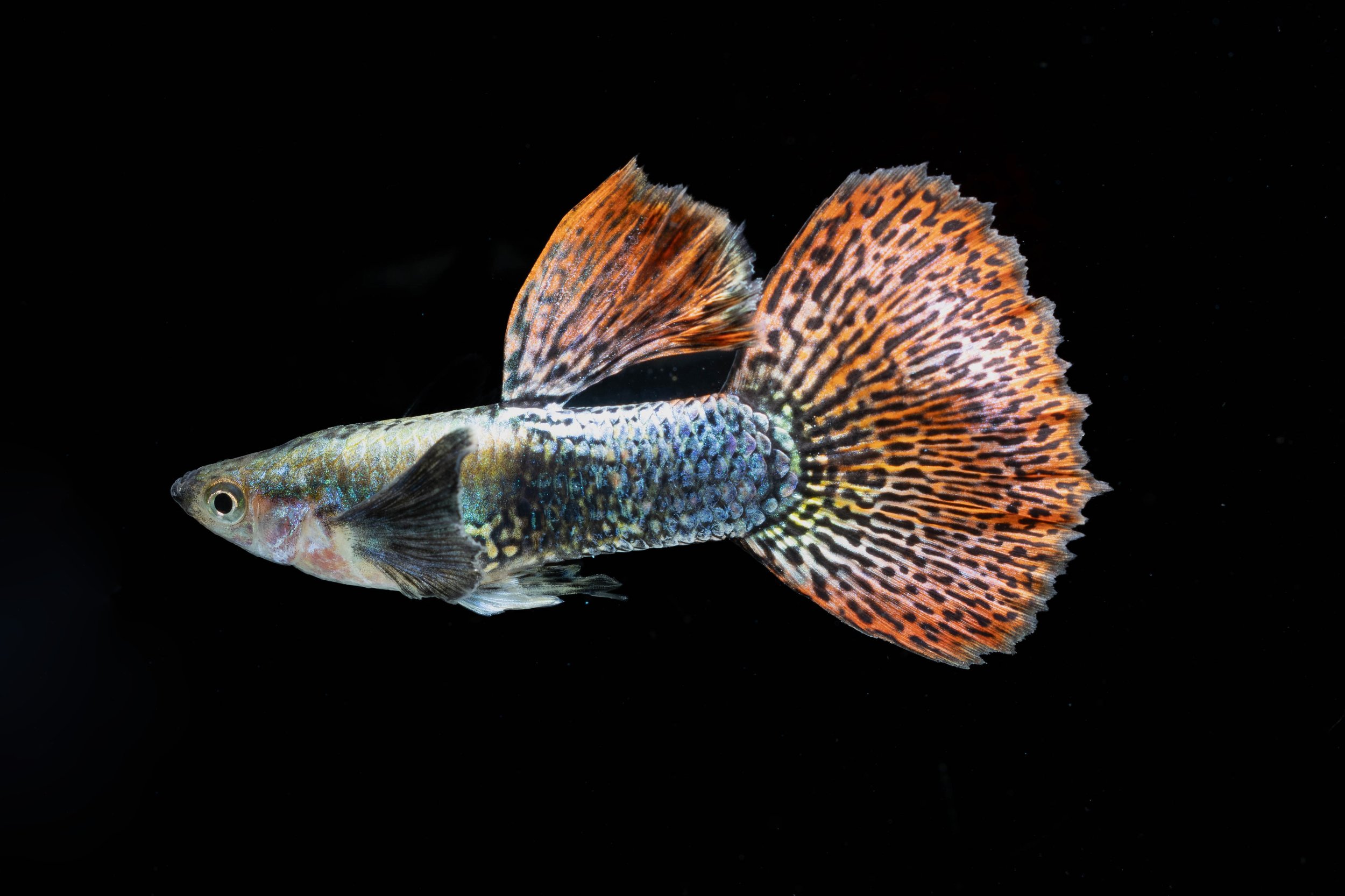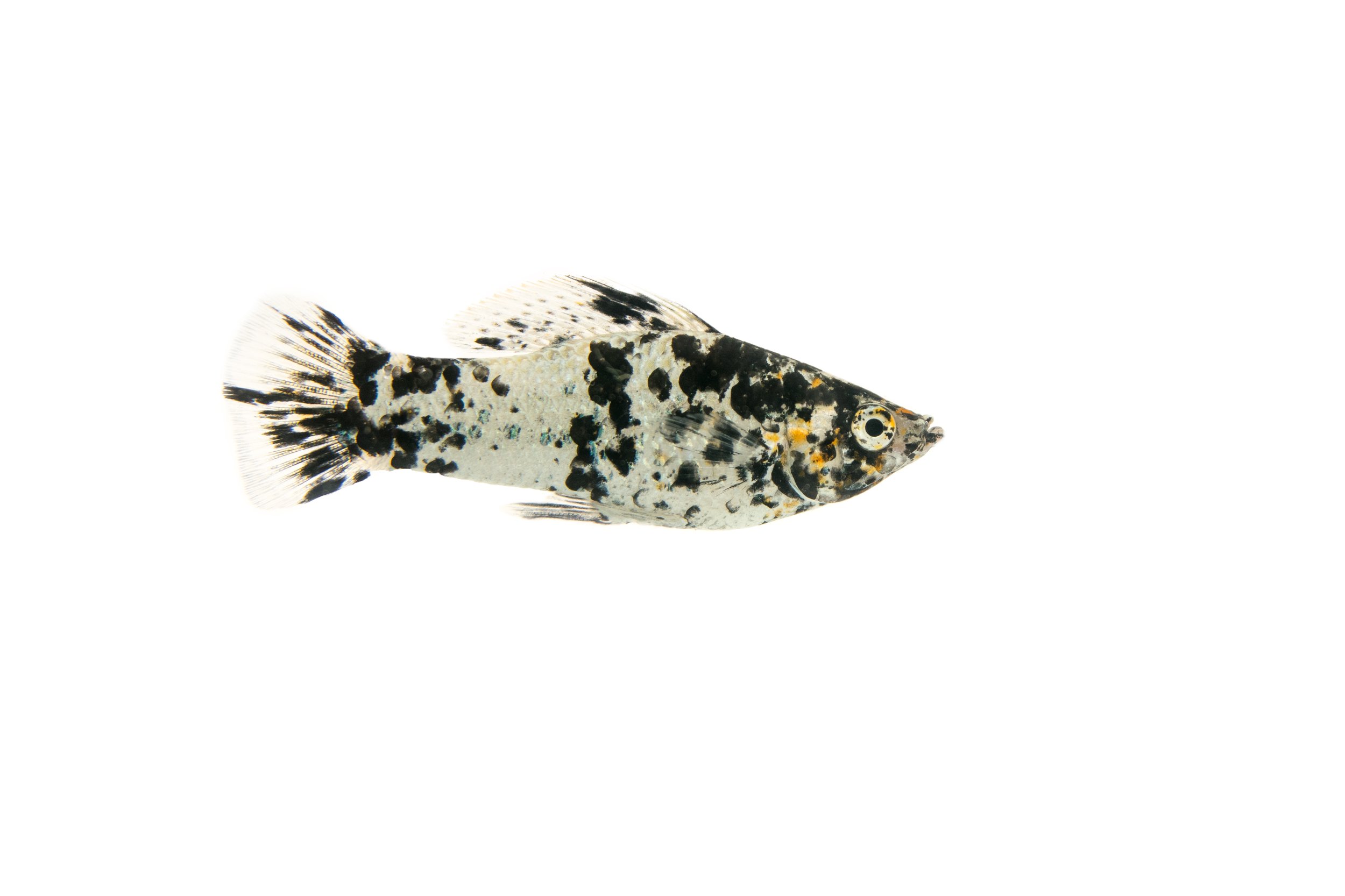 Image 1 of
Image 1 of


Liberty Molly-L
The Liberty Molly, scientifically known as Poecilia salvatoris, is a vibrant livebearing fish native to Central America, particularly El Salvador, Guatemala, Honduras, and Nicaragua. It was first introduced to the aquarium hobby in the 1930s. The common name “Liberty Molly” originates from the red, white, and blue coloration of the males’ fins, reminiscent of the American flag.
Adult Liberty Mollies typically reach about 3 inches (7.5 cm) in length, with females generally being larger than males. They have a silvery body speckled with blue and orange, and their fins display black and blue hues, along with either red or yellow. This species is known for its dynamic behavior and striking appearance.
A tank of at least 30 gallons is recommended for a small group of Liberty Mollies. They can be aggressive towards other tankmates and may nip fins, so it’s advisable to keep them in a species-specific tank. Maintaining a ratio of at least two females per male can help reduce aggression. The aquarium should have a secure lid, as they are prone to jumping.
Water parameters should include a temperature of 70 to 80°F (21 to 27°C), a pH between 6.5 and 7.5, and moderate hardness. Regular water changes and good filtration are essential to maintain water quality.
Feeding Liberty Mollies is straightforward, as they are omnivorous and accept a variety of foods. Offer high-quality flakes or pellets as a staple diet, and supplement with live or frozen foods like brine shrimp or bloodworms. They also require vegetable matter in their diet, so include algae wafers or blanched vegetables.
Liberty Mollies are livebearers and breed readily in captivity. Females give birth to live young, and a separate breeding tank with plenty of hiding spots can increase fry survival rates. Adults may eat their own young, so it’s important to provide cover or remove adults after birth.
The Liberty Molly (Poecilia salvatoris) is a captivating and lively species that adds vibrant color and activity to aquariums. With proper care and attention to their specific needs, they can be a rewarding addition for aquarists.
The Liberty Molly, scientifically known as Poecilia salvatoris, is a vibrant livebearing fish native to Central America, particularly El Salvador, Guatemala, Honduras, and Nicaragua. It was first introduced to the aquarium hobby in the 1930s. The common name “Liberty Molly” originates from the red, white, and blue coloration of the males’ fins, reminiscent of the American flag.
Adult Liberty Mollies typically reach about 3 inches (7.5 cm) in length, with females generally being larger than males. They have a silvery body speckled with blue and orange, and their fins display black and blue hues, along with either red or yellow. This species is known for its dynamic behavior and striking appearance.
A tank of at least 30 gallons is recommended for a small group of Liberty Mollies. They can be aggressive towards other tankmates and may nip fins, so it’s advisable to keep them in a species-specific tank. Maintaining a ratio of at least two females per male can help reduce aggression. The aquarium should have a secure lid, as they are prone to jumping.
Water parameters should include a temperature of 70 to 80°F (21 to 27°C), a pH between 6.5 and 7.5, and moderate hardness. Regular water changes and good filtration are essential to maintain water quality.
Feeding Liberty Mollies is straightforward, as they are omnivorous and accept a variety of foods. Offer high-quality flakes or pellets as a staple diet, and supplement with live or frozen foods like brine shrimp or bloodworms. They also require vegetable matter in their diet, so include algae wafers or blanched vegetables.
Liberty Mollies are livebearers and breed readily in captivity. Females give birth to live young, and a separate breeding tank with plenty of hiding spots can increase fry survival rates. Adults may eat their own young, so it’s important to provide cover or remove adults after birth.
The Liberty Molly (Poecilia salvatoris) is a captivating and lively species that adds vibrant color and activity to aquariums. With proper care and attention to their specific needs, they can be a rewarding addition for aquarists.
The Liberty Molly, scientifically known as Poecilia salvatoris, is a vibrant livebearing fish native to Central America, particularly El Salvador, Guatemala, Honduras, and Nicaragua. It was first introduced to the aquarium hobby in the 1930s. The common name “Liberty Molly” originates from the red, white, and blue coloration of the males’ fins, reminiscent of the American flag.
Adult Liberty Mollies typically reach about 3 inches (7.5 cm) in length, with females generally being larger than males. They have a silvery body speckled with blue and orange, and their fins display black and blue hues, along with either red or yellow. This species is known for its dynamic behavior and striking appearance.
A tank of at least 30 gallons is recommended for a small group of Liberty Mollies. They can be aggressive towards other tankmates and may nip fins, so it’s advisable to keep them in a species-specific tank. Maintaining a ratio of at least two females per male can help reduce aggression. The aquarium should have a secure lid, as they are prone to jumping.
Water parameters should include a temperature of 70 to 80°F (21 to 27°C), a pH between 6.5 and 7.5, and moderate hardness. Regular water changes and good filtration are essential to maintain water quality.
Feeding Liberty Mollies is straightforward, as they are omnivorous and accept a variety of foods. Offer high-quality flakes or pellets as a staple diet, and supplement with live or frozen foods like brine shrimp or bloodworms. They also require vegetable matter in their diet, so include algae wafers or blanched vegetables.
Liberty Mollies are livebearers and breed readily in captivity. Females give birth to live young, and a separate breeding tank with plenty of hiding spots can increase fry survival rates. Adults may eat their own young, so it’s important to provide cover or remove adults after birth.
The Liberty Molly (Poecilia salvatoris) is a captivating and lively species that adds vibrant color and activity to aquariums. With proper care and attention to their specific needs, they can be a rewarding addition for aquarists.





